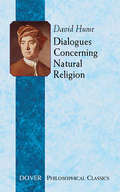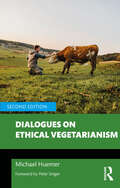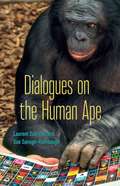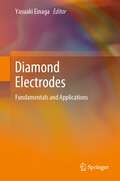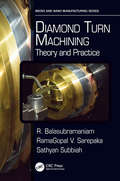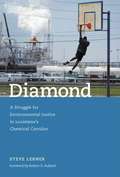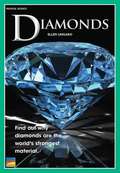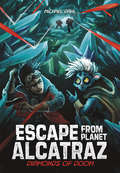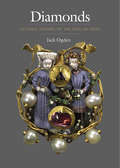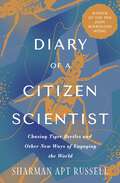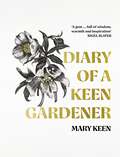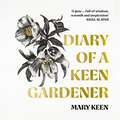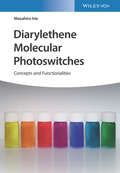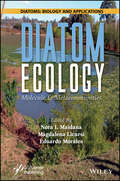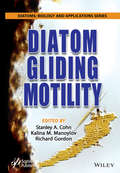- Table View
- List View
Dialogues Between Artistic Research and Science and Technology Studies (Routledge Advances in Art and Visual Studies)
by Trevor Pinch Peter Peters Henk BorgdorffThis edited volume maps dialogues between science and technology studies research on the arts and the emerging field of artistic research. The main themes in the book are an advanced understanding of discursivity and reasoning in arts-based research, the methodological relevance of material practices and things, and innovative ways of connecting, staging, and publishing research in art and academia. This book touches on topics including studies of artistic practices; reflexive practitioners at the boundaries between the arts, science, and technology; non-propositional forms of reasoning; unconventional (arts-based) research methods and enhanced modes of presentation and publication.
Dialogues Concerning Natural Religion
by David HumeHow can we know that God exists? Is it possible to find proof of religion's most significant issues? Can we presume that the orderliness of the universe offers evidence of a purposeful creator? David Hume's Dialogues Concerning Natural Religion explores these perennial questions in a thought-provoking and highly readable style.This classic examines its controversial subject in the well-known manner of the Platonic dialogues. Hume's characters discuss God's existence, his divinity and attributes, and the reasons behind his creation of the world. In clear, evocative prose, the debate's participants state and defend their positions, most of which center on the concept currently known as Intelligent Design. Hume's intense skepticism provides ingenious, persuasive refutations of the notion that reason and logic provide support for religious dogma. A work of historical importance as well as of ongoing relevance to modern life, this volume endures as both an inspiring philosophical inquiry and a literary gem.
Dialogues on Ethical Vegetarianism (Philosophical Dialogues on Contemporary Problems)
by Michael HuemerWorldwide every year, 83 billion animals are slaughtered on factory farms, at the end of brief lives full of suffering. Is it wrong to buy the products of this industry?In this book, two college students – a meat-eater and an ethical vegetarian – discuss this question in a series of dialogues conducted over five days. Issues covered include: how intelligence affects the badness of pain, whether consumers are responsible for the practices of the industry, how individual choices affect an industry, whether farm animals are better off living on factory farms than not existing at all, whether meat-eating is natural, whether morality protects those who cannot understand morality, whether morality protects those who are not members of society, whether humans alone possess souls, whether different creatures have different degrees of consciousness, why extreme animal welfare positions "sound crazy," and the role of empathy in moral judgment. The two go on to discuss the vegan life, why people who accept the arguments often fail to change their behavior, and how vegans should interact with non-vegans.This Second Edition also covers many new topics, including: Satisfying nutritional needs with plant-based foods The overall health effects of vegetarian diets The consumer costs of a plant-based diet Synthetic meat Food deserts Christian-inspired arguments for and against veganism Progressive-inspired arguments for and against veganism A new appendix offers readers delicious vegan recipes, including ones for Carrot Ginger Soup, Avocado Toast, Compassionate Chili, and The Smoothie of the Gods. Key Features: Thoroughly reviews the common arguments on both sides of the debate Dialogue format provides the most engaging way of introducing the issues Written in clear, conversational prose for a popular audience Offers new insights into the psychology of our dietary choices and our responsibility for influencing others New in this edition, several easy and delicious vegan recipes
Dialogues on the Human Ape (Posthumanities)
by Laurent Dubreuil Sue Savage-RumbaughA primatologist and a humanist together explore the meaning of being a &“human animal&”Humanness is typically defined by our capacity for language and abstract thinking. Yet decades of research led by the primatologist Sue Savage-Rumbaugh has shown that chimpanzees and bonobos can acquire human language through signing and technology. Drawing on this research, Dialogues of the Human Ape brings Savage-Rumbaugh into conversation with the philosopher Laurent Dubreuil to explore the theoretical and practical dimensions of what being a &“human animal&” means. In their use of dialogue as the primary mode of philosophical and scientific inquiry, the authors transcend the rigidity of scientific and humanist discourses, offering a powerful model for the dissemination of speculative hypotheses and open-ended debates grounded in scientific research.Arguing that being human is an epigenetically driven process rather than a fixed characteristic rooted in genetics or culture, this book suggests that while humanness may not be possible in every species, it can emerge in certain supposedly nonhuman species. Moving beyond irrational critiques of ape consciousness that are motivated by arrogant, anthropocentric views, Dialogues on the Human Ape instead takes seriously the continuities between the ape mind and the human mind, addressing why language matters to consciousness, free will, and the formation of the &“human animal&” self.
Dialysis Access Cases
by Alexander S. Yevzlin Arif Asif Robert R. Redfield III Gerald A. BeathardMoving beyond the science of hemodialysis access, this collection of clinical cases covers procedural and practical aspects of arteriovenous fistula, arteriovenous graft, dialysis catheter, draining veins, central veins, arterial interventions and hand ischemia. World experts in the disciplines of interventional nephrology, interventional radiology and surgery offer creative visions of their practice and provide insights on topics from routine access creation to advanced novel techniques. Dialysis Access Cases presents solutions to problems encountered in practice while capturing the art of this medical discipline and challenging procedure.
Diameter-Transformed Fluidized Bed: Fundamentals and Practice (Particle Technology Series #27)
by Wei Wang Mingyuan He Youhao Xu Bona Lu Yujie TianThis book puts forward the concept of the Diameter-Transformed Fluidized Bed (DTFB): a fluidized bed characterized by the coexistence of multiple flow regimes and reaction zones, achieved by transforming the bed into several sections of different diameters. It reviews fundamental aspects, including computational fluid dynamics simulations and industrial practices in connection with DTFB. In particular, it highlights an example concerning the development of maximizing iso-paraffins (MIP) reactors for regulating complex, fluid catalytic cracking reactions in petroleum refineries. The book is a must-have for understanding how academic and industrial researchers are now collaborating in order to develop novel catalytic processes.
Diamond Electrodes: Fundamentals and Applications
by Yasuaki EinagaThis book introduces the recent development in Japan of diamond electrodes, which has attracted much attention in the world. For example, electrochemical sensors using diamond electrodes are now being utilized commercially. Newly developing applications such as electrochemical organic synthesis including CO2 reduction are also expected to form an important future technology. Those emerging applications to various fields which are receiving increasing attention are described in detail here.This book is useful not only for students who would like to begin their study of diamond electrodes but also for industries that are exploring novel electrochemical applications.
Diamond Films Handbook
by Jes Asmussen D. K. ReinhardThe Diamond Films Handbook is an important source of information for readers involved in the new diamond film technology, emphasizing synthesis technologies and diamond film applications. Containing over 1600 references, drawings, photographs, micrographs, equations, and tables, and contributions by experts from both industry and academia, it inclu
Diamond Turn Machining: Theory and Practice (Micro and Nanomanufacturing Series)
by R. Balasubramaniam RamaGopal V. Sarepaka Sathyan SubbiahThe goal of this book is to familiarize professionals, researchers, and students with the basics of the Diamond Turn Machining Technology and the various issues involved. The book provides a comprehensive knowledge about various aspects of the technology including the background, components of the machine, mechanism of material removal, application areas, relevant metrology, and advances taking place in this domain. Solved and unsolved examples are provided in each of the areas which will help the readers to practice and get familiarized with that particular area of the Diamond Turn Machining process.
Diamond and Related Nanostructures
by Csaba Levente Nagy Mircea Vasile DiudeaOver the past twenty years, the field of carbon structures has been invigorated by the discovery of fullerenes and carbon nanotubes. These nano-structured carbons have attracted a tremendous interest in the fundamental properties of discrete carbon molecules, leading to the discovery of novel complex crystalline and quasi-crystalline materials. As a consequence, a variety of applications have been developed, including technical and bio-medical materials and miniaturized tools. Diamond and Related Nanostructures focuses on the advances in the area of diamond-like carbon nanostructures (hyper-structures built from fullerenes and/or carbon nanotube junctions) and other related carbon nanostructures. Each chapter contributes to the topic from different fields, ranging from theory to synthesis and properties investigation of these new materials. This volume brings together the major findings in the field and provides a source of inspiration and understanding to advanced undergraduates, graduates, and researchers in the fields of Physics, Graph Theory, Crystallography, Computational and Synthetic Chemistry.
Diamond-Like Carbon Coatings: Technologies and Applications
by Suchart Siengchin Sanjay Mavinkere Rangappa Peerawatt Nunthavarawong Kuniaki DohdaDiamond-like carbons (DLCs) display a number of attractive properties that make them versatile coating materials for a variety of applications, including extremely high hardness values, very low friction properties, very low gas permeability, good biocompatibility, and very high electrical resistivity, among others. Further research into this material is required to produce hydrogen-free DLC films and to synthesize it together with other materials, thereby obtaining better film properties. Diamond-Like Carbon Coatings: Technologies and Applications examines emerging manufacturing technologies for DLCs with the aim of improving their properties for use in practical applications. Discusses DLC coatings used in mechanical, manufacturing, and medical applications Details recent developments in the novel synthesis of DLC films Covers advances in understanding of chemical, structural, physical, mechanical, and tribological properties for modern material processing Highlights methods to yield longer service life Considers prospects for future applications of emerging DLC technologies This work is aimed at materials science and engineering researchers, advanced students, and industry professionals.
Diamond: A Struggle for Environmental Justice in Louisiana's Chemical Corridor
by Robert D. Bullard Steve LernerFor years, the residents of Diamond, Louisiana, lived with an inescapable acrid, metallic smell -- the "toxic bouquet" of pollution -- and a mysterious chemical fog that seeped into their houses. They looked out on the massive Norco Industrial Complex: a maze of pipelines, stacks topped by flares burning off excess gas, and huge oil tankers moving up the Mississippi. They experienced headaches, stinging eyes, allergies, asthma, and other respiratory problems, skin disorders, and cancers that they were convinced were caused by their proximity to heavy industry. Periodic industrial explosions damaged their houses and killed some of their neighbors. Their small, African-American, mixed-income neighborhood was sandwiched between two giant Shell Oil plants in Louisiana's notorious Chemical Corridor. When the residents of Diamond demanded that Shell relocate them, their chances of success seemed slim: a community with little political clout was taking on the second-largest oil company in the world. And yet, after effective grassroots organizing, unremitting fenceline protests, seemingly endless negotiations with Shell officials, and intense media coverage, the people of Diamond finally got what they wanted: money from Shell to help them relocate out of harm's way. In this book, Steve Lerner tells their story. Around the United States, struggles for environmental justice such as the one in Diamond are the new front lines of both the civil rights and the environmental movements, and Diamond is in many ways a classic environmental-justice story: a minority neighborhood, faced with a polluting industry in its midst, fights back. But Diamond is also the history of a black community that goes back to the days of slavery. In 1811, Diamond (then the Trepagnier Plantation) was the center of the largest slave rebellion in United States history. Descendants of these slaves were among the participants in the modern-day Diamond relocation campaign. Steve Lerner talks to the people of Diamond, and lets them tell their story in their own words. He talks also to the residents of a nearby white neighborhood -- many of whom work for Shell and have fewer complaints about the plants -- and to environmental activists and Shell officials. His account of Diamond's 30-year ordeal puts a human face on the struggle for environmental justice in the United States.
Diamonds of Doom (Escape from Planet Alcatraz)
by Michael DahlTraveling by night, Zak Nine and Erro are following a shadowy figure until the mysterious stranger disappears into a cave. The boys decide to follow. Inside they find a maze filled with priceless gems, along with a rough band of escaped criminals. Things go from bad to worse when a squad of Alcatraz guards arrives on the scene. When the guards start shooting their laser blasters, suddenly nobody is safe! Will Zak and Erro escape the deadly storm of laser fire, or will they be trapped in the endless dark forever?
Diamonds: An Early History of the King of Gems
by Jack OgdenA lavishly illustrated, in-depth early history covering two thousand years of diamond jewelry and commerce, from the Indian mines to European merchants, courts, and workshops This richly illustrated history of diamonds illuminates myriad facets of the “king of gems,” including a cast of larger-than-life characters such as Alexander the Great, the Mughal emperor Jahangir, and East India Company adventurers. It’s an in-depth study tracing the story of diamonds from their early mining and trade more than two thousand years ago to the 1700s, when Brazil displaced India as the world’s primary diamond supplier. Jack Ogden, a historian and gemologist specializing in ancient gems and jewelry, describes the early history of diamond jewelry, the development of diamond cutting, and how diamonds were assessed and valued. The book includes more than one hundred captivating images, from close-up full-color photographs of historic diamond-set jewelry (some previously unpublished), to photomicrographs of individual gems and illustrations of medieval manuscripts, as well as diagrams depicting historical methods of cutting and polishing diamonds.
Diary and Observations of Thomas Alva Edison
by Dagobert D. RunesGain insight into the unique thinking and philosophy of the world&’s most prolific inventor with this collection of his writings.American scientist and businessman Thomas Edison contributed much to the well-being and comfort of our modern life. He gave us the electric light, the phonograph, and the motion-picture camera, along with more than one thousand other inventions. Edison was, as fellow inventor Guglielmo Marconi put it, &“one of the world&’s greatest benefactors.&” In this volume, editor Dagobert D. Runes presents Edison&’s diary along with a selection of his social and philosophical ideas taken from available notes, statements, and observations. Readers will discover that many of Edison&’s casual remarks made decades ago have a definite contemporary significance. His propositions in ethics, philosophy, music, and education show a rare combination of whimsy and deep sincerity.
Diary of a Citizen Scientist: Chasing Tiger Beetles and Other New Ways of Engaging the World
by Sharman Apt RussellA critically acclaimed nature writer explores the citizen scientist movement through the lens of entomological field research in the American Southwest. Award-winning nature writer Sharman Apt Russell felt pressed by the current environmental crisis to pick up her pen yet again. Encouraged by the phenomenon of citizen science, she decided to turn her attention to the Western red-bellied tiger beetle, an insect found widely around the world and near her home in the Gila River Valley of New Mexico. In a lyrical, often humorous voice, Russell shares her journey across a wild, rural landscape tracking this little-known species, an insect she calls &“charismatic,&” &“elegant,&” and &“fierce.&” What she finds is renewed optimism in mysteries still left to be explored, that despite the challenges of climate change, there is a growing diversity of ways ordinary people can contribute to the research needs of scientists today in the name of environmental activism. Offering readers a glimpse into the pioneering field of citizen science, Diary of a Citizen Scientist documents one woman&’s transformation from a feeling of powerlessness to engaged hopefulness.Winner of the John Burroughs Medal and the WILLA Literary Award for Best Creative NonfictionNamed one of the top ten best nature books of 2014 by GrrlScientist in The Guardian
Diary of a Keen Gardener
by Mary Keen'A gem of a book. Full of wisdom, warmth and inspiration. I learned something from every page' NIGEL SLATER'A delightful book - warm, witty and wise' ALAN TITCHMARSH'A beautiful refraction of a year, encounters with plants and friends and gardens in the terrific company of Mary Keen. Her diary is a pure delight' EDMUND DE WAAL'What's your favourite garden?' people ask. And when I answer, 'Mine, of course,' they look surprised.Over her long career, Mary Keen has created some of the finest gardens in England. But rather than tell the story of those paradises, this is the diary about everyday watchfulness in the places Mary loves best - her own back garden and allotment nearby. Beginning at the lowest ebb of the grower's year - when November leaves are falling and flowers in retreat - Mary shows us how one's perspective of time changes in the pleasure of nurturing plants. Time can slide to a standstill as you stop to stare at a flower, or flash to the past when another triggers a memory. As the diary records the ordinary, the ephemeral and the horticulturally useful, in a patchwork of life and tasks, we also witness the little dramas in the village where she lives and meet her family and friends who are an integral part of her gardening community.By the time Diary of a Keen Gardener reaches back to November again, the reader has gained much practical knowledge and come to understand Mary's gardening philosophy, and what she continues to learn about plants, ecology and life. Her diary is an essential book for anyone with an interest in gardening.'Mary Keen is the Annie Ernaux of the herbaceous border. She has vast reserves of knowledge, an exemplary eye and best of all a roving curiosity and rare openness to experiment and change. A gorgeous, constantly thought-provoking book, beguiling for gardeners and readers alike' OLIVIA LAING
Diary of a Keen Gardener
by Mary Keen'A gem of a book. Full of wisdom, warmth and inspiration. I learned something from every page' NIGEL SLATER'A delightful book - warm, witty and wise' ALAN TITCHMARSH'A beautiful refraction of a year, encounters with plants and friends and gardens in the terrific company of Mary Keen. Her diary is a pure delight' EDMUND DE WAAL'What's your favourite garden?' people ask. And when I answer, 'Mine, of course,' they look surprised.Over her long career, Mary Keen has created some of the finest gardens in England. But rather than tell the story of those paradises, this is the diary about everyday watchfulness in the places Mary loves best - her own back garden and allotment nearby. Beginning at the lowest ebb of the grower's year - when November leaves are falling and flowers in retreat - Mary shows us how one's perspective of time changes in the pleasure of nurturing plants. Time can slide to a standstill as you stop to stare at a flower, or flash to the past when another triggers a memory. As the diary records the ordinary, the ephemeral and the horticulturally useful, in a patchwork of life and tasks, we also witness the little dramas in the village where she lives and meet her family and friends who are an integral part of her gardening community.By the time Diary of a Keen Gardener reaches back to November again, the reader has gained much practical knowledge and come to understand Mary's gardening philosophy, and what she continues to learn about plants, ecology and life. Her diary is an essential book for anyone with an interest in gardening.'Mary Keen is the Annie Ernaux of the herbaceous border. She has vast reserves of knowledge, an exemplary eye and best of all a roving curiosity and rare openness to experiment and change. A gorgeous, constantly thought-provoking book, beguiling for gardeners and readers alike' OLIVIA LAING
Diary of a Keen Gardener
by Mary Keen'A gem of a book. Full of wisdom, warmth and inspiration. I learned something from every page' NIGEL SLATER'A delightful book - warm, witty and wise' ALAN TITCHMARSH'A beautiful refraction of a year, encounters with plants and friends and gardens in the terrific company of Mary Keen. Her diary is a pure delight' EDMUND DE WAAL'What's your favourite garden?' people ask. And when I answer, 'Mine, of course,' they look surprised.Over her long career, Mary Keen has created some of the finest gardens in England. But rather than tell the story of those paradises, this is the diary about everyday watchfulness in the places Mary loves best - her own back garden and allotment nearby. Beginning at the lowest ebb of the grower's year - when November leaves are falling and flowers in retreat - Mary shows us how one's perspective of time changes in the pleasure of nurturing plants. Time can slide to a standstill as you stop to stare at a flower, or flash to the past when another triggers a memory. As the diary records the ordinary, the ephemeral and the horticulturally useful, in a patchwork of life and tasks, we also witness the little dramas in the village where she lives and meet her family and friends who are an integral part of her gardening community.By the time Diary of a Keen Gardener reaches back to November again, the reader has gained much practical knowledge and come to understand Mary's gardening philosophy, and what she continues to learn about plants, ecology and life. Her diary is an essential book for anyone with an interest in gardening.'Mary Keen is the Annie Ernaux of the herbaceous border. She has vast reserves of knowledge, an exemplary eye and best of all a roving curiosity and rare openness to experiment and change. A gorgeous, constantly thought-provoking book, beguiling for gardeners and readers alike' OLIVIA LAING
Diary of an Apprentice Astronaut
by Samantha CristoforettiAstronaut Samantha Cristoforetti’s intimate account of her first journey to the International Space Station, to which she returns in 2022, as commander of Expedition 68a—only the fourth woman to command the ISS, praised by Scott Kelly for its “incredible detail and great writing.” Two hundred days orbiting Earth on the International Space Station. Five years working and training with the aerospace community across the world. A lifetime of choices leading to the stars. These are the components of Samantha Cristoforetti’s dream, a dream she invites us to share in this intimate account of an astronaut’s journey to space. She views the triumphs and disappointments of that journey with a poet’s eye and a philosopher’s mind—and an engineer’s gift for detail that brings each experience into sharp focus. With Cristoforetti as our guide, we’re called to become “apprentice astronauts” and experience the world anew through the visor of a space suit’s helmet. Bonding with crew members to tackle challenges as a team, lifting off from the launchpad in a roar of engines, discovering the strange wonders of weightlessness, seeing Earth with a fresh perspective after a bittersweet return to solid ground . . . all these moments and more reveal what it really takes to escape our planet’s gravity in pursuit of a goal.
Diarylethene Molecular Photoswitches: Concepts and Functionalities
by Masahiro IrieA comprehensive review to the synthesis, properties, and applications of diarylethene-based molecular photoswitches Diarylethene Molecular Photoswitches: Concept and Functionalities provides the fundamental concepts of molecular photoswitches and includes information on how the bistable photoswitches of diarylethenes modulate the functions of materials and biological activities. Written by Masahiro Irie (the inventor of photochromic diarylethene compound), the book explores the reaction mechanism, photoswitching performance, photoswitchable crystals, and the myriad applications of diarylethenes based photoswitches. This book offers academics, chemists, and engineers an essential resource for understanding the molecular photoswitches and provides a guide to the development of new photoresponsive materials. The author explores the applications based on diarylethene and its dirivatives to Field-Effect Transistors, Metal-Organic Frameworks including nanoparticles, super-resolution fluorescence microscopies, drug release, and self-healing materials. This important book: * Offers a guide to diarylethene derivatives, the most widely studied compounds worldwide among the photochromic compounds * Includes the basic concepts of molecular photoswitches * Explores the myraid applications grounded in diarylethene and its derivatives * Presents an authortative text from the inventor of the photochromic diarylethene compound Written for materials scientists, organic, polymer, and physical chemists, and electronics engineers, Diarylethene Molecular Photoswitches offers an introduction to the topic and includes recent developments in the field.
Diatom Cultivation for Biofuel, Food and High-Value Products (Diatoms: Biology and Applications)
by Richard Gordon Vandana VinayakThis unique book examines the techno-economic prospects of diatom cultivation, the design and implementation of algal reactors, and the potential of diatoms as a source of biofuel and other value-added products. Diatom Cultivation for Biofuel, Food and High-Value Products covers the scientific, economic, and practical aspects of using diatoms for multiple purposes. It explores an integrated approach to diatom cultivation, including discussions on techniques, harvesting methods, and innovative technologies. The book discusses the potential of these techniques for improving the efficiency and yield of diatom-based biofuels, as well as the challenges and ethical considerations associated with genetic engineering. Readers of the book will discover a wealth of information including: The adaptation of chitosan-based harvesting methods for microalgae flocculation; the trends, scope, and techno-economic prospects of diatom cultivation, including the design and implementation of algal reactors and the potential of diatoms as a source of biofuel and other value-added products. Advanced applications and innovative techniques in the field of diatoms and microalgae such as an in-depth analysis of the pigments and proteins found in Phaeodactylum tricornutum; the nature and applications of diatom cell walls, including their purification processes and industrial uses; the biochemical engineering of diatoms for health and biorefinery concepts, highlighting the potential of diatoms in producing biofuels and other high-value products; the metabolic and transcriptomic stress and engineering of diatoms to enhance lipid production, exploring the stress conditions that can increase oil yield; explores the genetic engineering techniques, such as CRISPRCas9 and RNA interference. The environmental and industrial applications of diatoms for low-value products, such as diatom as a prospective green anode material; diatom cell disruption and milking via a nano biorefinery for biofuel production, utilizing techniques like pulsed electric fields, high-pressure homogenization, ultrasonication, etc; genetic engineering and metabolic engineering in diatoms for oil production; the use of diatoms for heavy metal bioremediation, exploring the mechanisms of heavy metal uptake by diatoms, including biosorption and bioaccumulation; the transesterification of diatom oil and parameters for optimization; diatom harvesting for lipid production like bubble wrap (Bubble Farming). Audience The book serves as a guide for researchers and scientists in phycology, biology, ecology, environmental science, biofuels, bioengineering as well as nutritionists and dieticians who design functional foods and nutraceutical products.
Diatom Ecology: Molecule to Metacommunities (Diatoms: Biology and Applications)
by Eduardo Morales Nora I. Maidana Magdalena LicursiThis book offers a comprehensive, unique and up-to-date exploration of diatom ecology spanning from fundamental molecular aspects to the intricate dynamics of metacommunities. In recent years there has been a considerable increase in the amount of research devoted to diatom ecology, with a wide spectrum of approaches. This large amount of information, published in many different journals and books, makes it very difficult to keep up to date, both for the trained researcher and for students. Eduardo A. Morales (d. May 2023) had the original idea to assemble chapters on various subjects within diatom ecology. The questions he posed to potential contributors framed the current book consisting of 12 chapters. Are diatoms suitable tools for ecological restoration? What would be the features that make them reliable in this context? What makes diatoms ecologically successful? In an ecological sense, why is there such variability in diatom reproductive strategies and why are they worth considering? What do new approaches in ecological synthesis provide to diatom ecology, biogeography and metacommunities? Are all diatoms widely spread and each species uniquely characterized by its own, unaltered phenotype? Can we really make any ecological consideration without knowing (with a high degree of certainty) the identity of taxa? Are urban ecosystems important repositories of biodiversity? What are the benefits and the progress in diatom ecology made by the diatom guild perspective? Why, how and when are soil diatoms used in bioindication and what are the benefits of such an approach? Are diatoms bona fide indicators of climate change? Are diatom communities in temporary rivers important for these lotic ecosystems as they are subjected to the effects of climate change? Do diatoms in peatlands behave differently from their terrestrial and aquatic (rivers, lakes, others) counterparts? Audience The book is intended primarily for professionals in the fields of diatom research, algal research (phycology), organismal, population and community ecology, limnology, microbiology, organismal biology, paleoecology and paleolimnology. The book will also serve as a reference for graduate students seeking guidance on terminology, techniques, and current methods in diatom research.
Diatom Gliding Motility
by Richard Gordon Stanley Cohn Kalina ManoylovThe book will cover a broad range of work describing our current state of understanding on the topic, including: historic knowledge and misconceptions of motility; evolution of diatom motility; diatom ecology & physiology; cell biology and biochemistry of diatom motility, anatomy of motile diatoms; observations of diatom motile behavior; diatom competitive ability, unique forms of diatom motility as found in the genus Eunotia; and Models of Motility. This volume is the first book attempting to gather such information surrounding diatom motility into one volume focusing on this single topic. Readers will be able to gather both the current state of understanding on the potential mechanisms and ecological regulators of motility, as well as possible models and approaches used to help determine how diatoms accomplish such varied behaviors as diurnal movements, accumulation into areas of light, niche partitioning to increase species success. Given the fact that diatoms remain one of the most ecologically crucial cells in aquatic ecosystems, our hope is that this volume will act as a springboard towards future research into diatom motility and even better resolution of some of the issues in motility.

